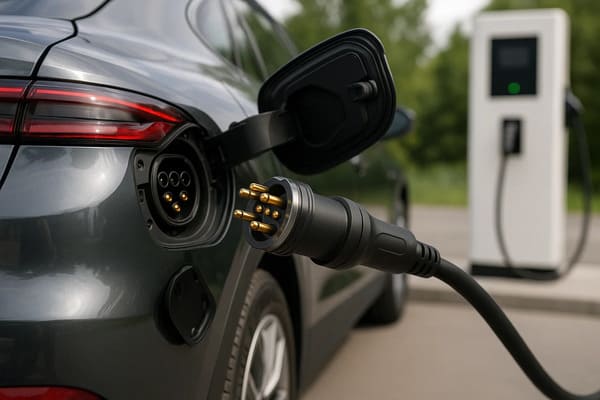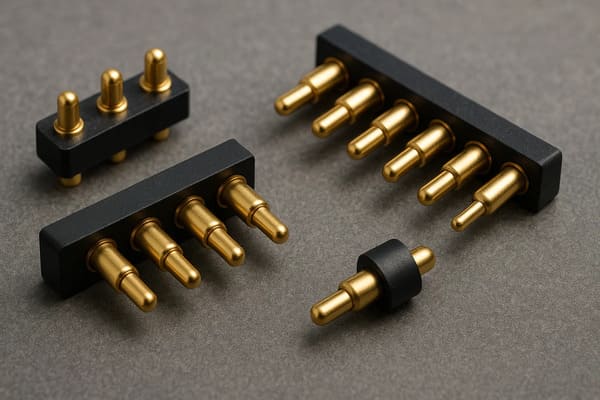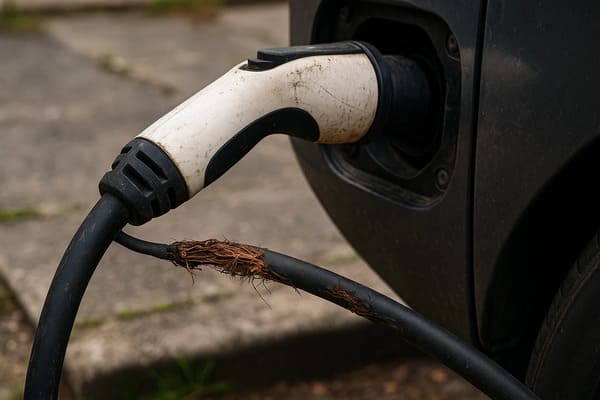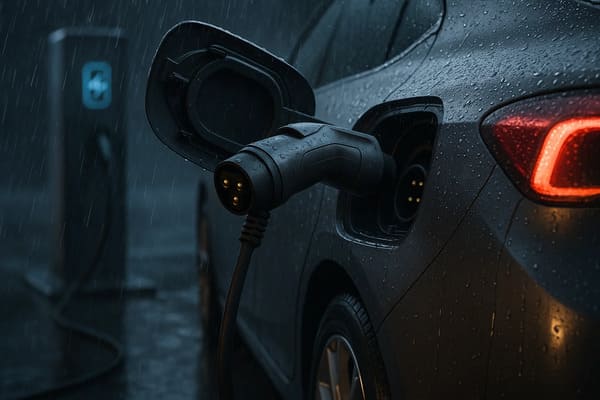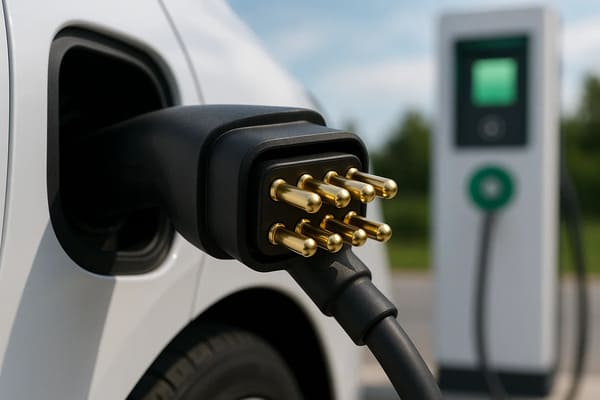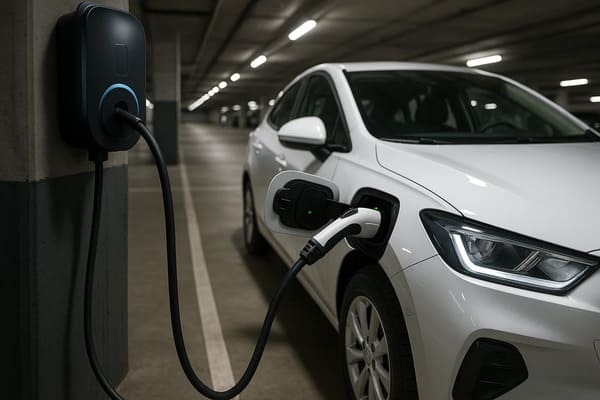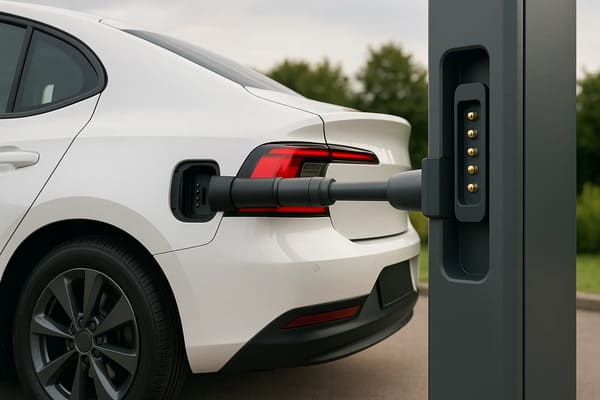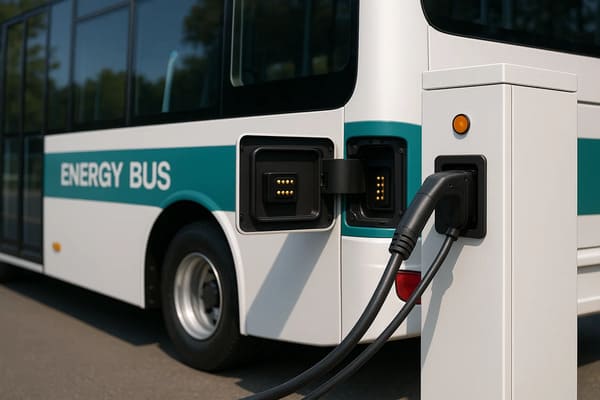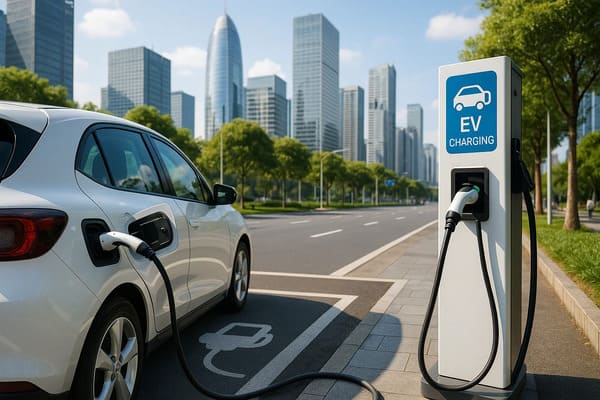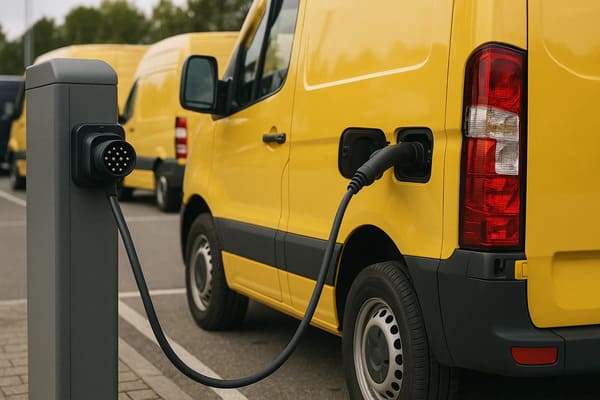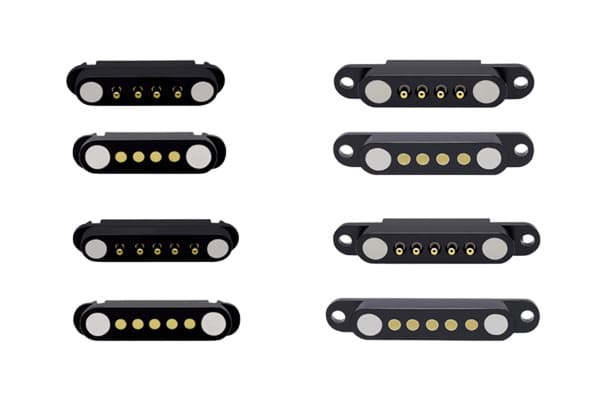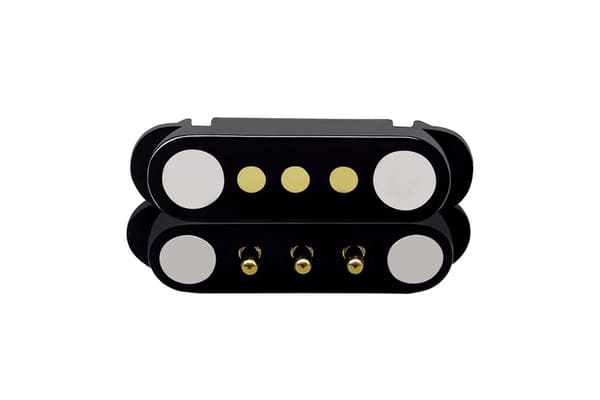Tired of slow, unreliable EV charging?
Bulky cables and connector wear frustrate owners, fueling range anxiety and charging headaches, while inefficient charging impacts our environment.
It’s time for a change. Pogo pin technology offers a robust, efficient, and innovative alternative for New Energy Vehicle (NEV) charging. This blog explores its significant benefits.
Pogo pin charging solutions benefit New Energy Vehicles by enhancing durability through robust spring-loaded connections.
They enable automated, hands-free charging, improving user convenience.
Furthermore, the contained design contributes to improved safety by reducing exposure to electrical components.
This approach promises a more reliable charging experience.
This shift towards advanced connection methods is crucial.
As the NEV market grows, the demand for better charging infrastructure becomes more urgent.
We need solutions that are not just functional but also seamlessly integrated into our lives and support a sustainable future.
Let’s explore why pogo pin connectors are poised to be a key part of this evolution.
What Exactly is Pogo Pin Connector Technology and How Does It Work?
Ever wondered about the mechanics behind seamless electronic connections?
Many advanced devices rely on pogo pin connectors, but their application in EV charging is a newer, exciting development.
Understanding this technology is key.
Pogo pin connectors are spring-loaded electrical contacts designed to establish consistent and reliable connections.
They function by maintaining constant pressure between two points, accommodating minor movement or misalignment.
This mechanism ensures stable electrical continuity, even in dynamic or vibratory environments, making them suitable for various applications.
1. The Inner Workings of Pogo Pin Connectors in Charging
- Plunger: This is the part that makes contact with the charging pad or port on the vehicle.
It’s typically made of highly conductive materials and often plated with gold for corrosion resistance and durability. - Spring: Located inside the barrel, the spring provides the necessary force to maintain contact.
It allows the plunger to retract and extend, accommodating variations in distance and alignment. - Barrel: This houses the spring and plunger, guiding the plunger’s movement and providing a stable structure for the connection.
2. Key Characteristics of Pogo Pin Connectors
Pogo pin connectors, including magnetic pogo pin variants, bring several advantageous characteristics to the table for EV charging:
| Characteristic | Description | Benefit for EV Charging |
|---|---|---|
| Durability | Designed for many mating cycles; resistant to wear and tear. Materials like gold plating enhance this. | Longer lifespan for charging equipment, less maintenance. |
| High Current Capacity | Can be engineered to handle significant electrical currents safely. | Suitable for fast charging of NEV batteries. |
| Compact Size | Relatively small, allowing for more space-efficient designs. | Sleeker charging stations and vehicle integration. |
| Precise Contact | Spring mechanism ensures consistent, reliable contact even with minor misalignments. | Efficient power transfer, reduced risk of connection failure. |
| Versatility | Can be customized for various applications and environments. | Adaptable to different vehicle types and charging scenarios. |
Understanding the core principles of these connectors reveals their suitability for demanding applications.
Their design allows for reliable power and data transfer.
This technology offers a robust solution for evolving connectivity needs.
Why Do Traditional EV Charging Methods Fall Short for Modern Electric Vehicles?
Struggling with cumbersome EV cables or worried about connector damage?
These common frustrations highlight the need for better charging solutions as electric vehicle adoption grows.
Traditional methods have several drawbacks.
Traditional EV charging methods often fall short due to several limitations.
They typically involve manual connections, leading to wear and tear on cables and ports over time.
Additionally, exposure to environmental factors can cause damage.
These issues can result in reduced reliability and inconvenience for users, hindering the charging experience.
1. Deep Dive into Cable-Based Charging Limitations
- Wear and Tear: Constant plugging and unplugging lead to mechanical stress on both the cable connectors and the vehicle’s charging port.
This can result in loose connections, increased electrical resistance, and eventual failure.
I’ve heard from many EV owners about frayed cables or damaged port pins. - Bulkiness and Storage: High-power charging cables are often thick, heavy, and cumbersome to handle and store.
This is particularly an issue for users with limited mobility or in tight parking spaces. - Environmental Susceptibility: Connectors exposed to rain, snow, dust, and extreme temperatures can corrode or degrade.
While many are designed with some protection, it’s not always foolproof, leading to potential safety hazards or connection issues. - Manual Connection Effort: The need to manually plug in the vehicle every time can be a minor inconvenience that adds up.
There’s also the risk of improper connection if not fully inserted, potentially leading to slower charging or no charge at all. - Limited Automation Potential: Cable-based systems are difficult to automate fully.
While some robotic arms can plug in cables, the solutions are often complex and expensive compared to inherently automatable designs.
2. A Brief Look at Wireless (Inductive) Charging Challenges
- Lower Efficiency: Inductive charging typically has lower energy transfer efficiency compared to conductive charging.
This means more energy is lost as heat, leading to slightly higher charging costs and a greater environmental footprint per charge. - Alignment Sensitivity: Efficiency in wireless charging is often highly dependent on precise alignment between the charging pad and the vehicle’s receiver.
Misalignment can significantly reduce charging speed or prevent charging altogether. - Higher Cost: The technology for high-power wireless EV charging can be more expensive to implement in both the vehicle and the charging infrastructure.
- Potential for EMF Concerns: While generally considered safe within established limits, some users may have concerns about electromagnetic field (EMF) exposure, especially with higher power systems.
The limitations of traditional methods highlight a clear need for advanced charging solutions.
Exploring alternatives can improve user experience and system longevity.
Adopting new technologies is essential for the future of electric mobility.
What Are the Game-Changing Benefits of Pogo Pin Charging Solutions for New Energy Vehicles?
Frustrated by fragile EV chargers or inconvenient plugging routines?
Pogo pin charging offers a robust and user-friendly alternative that could revolutionize your EV experience.
It’s about more than just power; it’s about reliability.
Pogo pin charging solutions offer several significant benefits for New Energy Vehicles.
They provide enhanced durability and a superior user experience through potential automation.
Additionally, these solutions increase safety and allow for flexible design integration.
These advantages contribute to long-term cost-effectiveness, making them a strong option for modern EV infrastructure.
1. Enhanced Durability and Reliability with Pogo Pins
- Resistance to Vibration and Shock: Vehicles, by nature, experience vibrations and occasional shocks.
Pogo pins, with their spring-loaded design, maintain a constant connection even under these conditions.
This is a significant advantage over rigid connectors that can loosen or fail. - Sealed Design for Environmental Protection: High-quality pogo pin connector systems can be designed with excellent sealing (e.g., IP67 or IP68 ratings), making them waterproof and dustproof.
This is crucial for outdoor charging stations or systems integrated into the vehicle’s undercarriage, protecting against rain, snow, and road debris. - Longer Lifespan due to Reduced Wear: Pogo pins are typically rated for tens of thousands, even hundreds of thousands, of mating cycles.
The rolling or wiping action of the plunger against the contact pad, combined with durable materials like gold plating, minimizes wear compared to the scraping and friction in traditional connectors.
This translates to lower maintenance and a longer operational life for the charging system.
2. Improved User Experience with Pogo Pin Connectors
- Automatic and Hands-Free Connection: This is a major leap forward. Pogo pins are ideally suited for automated charging systems.
Imagine simply parking your NEV, and a robotic arm extends a pogo pin array, or a ground-based unit rises to connect automatically.
No cables, no fuss. This is particularly beneficial for autonomous vehicles. - Faster and More Efficient Charging Cycles: The precise and reliable contact established by pogo pins ensures optimal electrical conductivity.
This can lead to more consistent charging speeds and reduced energy loss compared to connections that might degrade or have higher resistance over time. - "Drive-Over" or "Docking" Convenience: Pogo pin systems can be designed for "drive-over" pads in parking spots or "docking" stations where the vehicle simply aligns itself for charging.
This eliminates the need for the driver to handle any equipment, making the process effortless.
For example, a fleet of electric buses could automatically charge at a depot overnight using such a system.
3. Safety Advantages of Pogo Pin Charging Systems
- Reduced Risk of Electrical Arcing: Advanced pogo pin charging systems can incorporate "hot-plug" protection.
This means the power is only applied after a secure connection is established and typically cut before disconnection, significantly reducing the risk of electrical arcing, which can damage connectors and pose a safety hazard. - Secure and Stable Connection: The spring force in pogo pins ensures a consistently secure and stable electrical connection.
This reduces the chances of intermittent contact, overheating, or accidental disconnection that can occur with worn or improperly inserted traditional connectors. - Tamper-Resistant Designs: Pogo pin charging interfaces, especially those integrated into the vehicle or ground, can be designed to be more tamper-resistant than exposed cable connectors.
This can deter vandalism and unauthorized access, enhancing the security of [public charging infrastructure](Why electric vehicle charger security matters "public charging infrastructure").
4. Design Flexibility and Integration for NEVs and Infrastructure
- Compact Footprint: Pogo pins and their corresponding contact pads are generally smaller and more discreet than traditional charging ports and plugs.
This allows automotive designers to create sleeker vehicle profiles without bulky charging flaps.
Charging stations can also be less obtrusive and more aesthetically pleasing. - Enables Innovative Charging Solutions: The technology facilitates novel charging concepts.
This includes integration into parking spots (as mentioned).
At these automated battery swapping stations, pogo pins handle the electrical connection to the battery pack, or even dynamic charging concepts (though this is more futuristic). - Scalability for Various Power Requirements: Pogo pin arrays can be scaled in number and size to handle different power levels, from lower-power charging for smaller NEVs or e-bikes to high-power fast charging for buses and trucks.
5. Cost-Effectiveness (Long-Term) of Pogo Pin Solutions
- Reduced Maintenance and Replacement Costs: Due to their enhanced durability and resistance to wear, pogo pin-based charging systems generally require less maintenance and have a longer lifespan than traditional cable systems.
This means fewer replacements of cables, connectors, and charging ports over the vehicle’s life and the charging station’s operational period. - Potential for Higher Throughput at Charging Stations: Automated pogo pin charging can significantly reduce the time it takes to connect and disconnect a vehicle.
In commercial settings like taxi ranks or delivery fleet depots, this can lead to higher throughput, meaning more vehicles can be charged in the same amount of time, maximizing asset utilization. - Enabling New Business Models: Fully automated charging depots, operating 24/7 without manual intervention, become feasible.
This can lead to new business models for fleet operators or public charging providers, potentially reducing operational labor costs.
The integration of pogo pin technology marks a significant advancement in EV charging.
Its benefits extend beyond simple power delivery, fostering a more reliable, convenient, and efficient future for new energy vehicles.
Where Are Pogo Pin Charging Solutions Making an Impact and What’s Next for NEVs?
Curious if pogo pin charging is just a concept or already in use.
While widespread NEV adoption is emerging, similar pogo pin applications in other fields showcase their proven reliability and offer a glimpse into the future.
Pogo pin charging solutions are currently utilized in demanding commercial applications such as AGVs and robotics, where reliability and frequent charging cycles are essential.
For NEVs, they’re set to enable automated charging for autonomous vehicles, streamline commercial fleet operations, and integrate into smart city infrastructure.
1. Current Uses Paving the Way
- Automated Guided Vehicles (AGVs) & Robotics: In warehouses and factories, AGVs and mobile robots often use pogo pin-based docking stations for automated charging.
These environments demand high reliability and frequent charge cycles, conditions where pogo pins excel. - Commercial Fleets (Concept/Niche): Some niche commercial electric vehicles, or concept designs for electric buses and trucks, have explored pogo pin or similar conductive automated charging systems for depot charging.
The benefits of quick, automated turnaround are very attractive for fleet operations. - Specialized Equipment: Pogo pins are used in various devices requiring robust and repeated connections, from medical equipment to data terminals.
This broad base of successful applications underscores their reliability.
2. Emerging Trends in Pogo Pin Charging for NEVs
The future potential for pogo pin charging in the New Energy Vehicle sector is exciting, driven by several key trends:
| Emerging Trend | Description | Impact of Pogo Pins |
|---|---|---|
| Automated Charging for Autonomous Vehicles (AVs) | Self-driving cars will require fully autonomous charging without human intervention. | Pogo pins are ideal for robotic or automated ground-based connections, essential for true AV autonomy. |
| Charging Infrastructure for Commercial Fleets | Electric buses, delivery vans, and trucks need efficient, high-throughput charging, often in depots. | Automated pogo pin systems can minimize downtime and labor costs for large fleets. |
| Integration into Smart Cities & Public Parking | Future smart cities will feature intelligent parking solutions with integrated charging. | Pogo pins allow for discreet, automated charging embedded in parking spots, enhancing convenience and aesthetics. |
| Battery Swapping Solutions for NEVs | Some NEV models or fleet operations may utilize battery swapping for instant "refueling." | Reliable, high-current pogo pin connectors are crucial for the electrical interface between the vehicle and battery pack. |
With their spring-loaded and sealed designs, pogo pin charging solutions provide unmatched durability, reliability, and environmental protection for NEVs.
This advanced technology ensures an automated, hands-free connection, delivering a truly effortless and superior electric vehicle charging experience.
What Challenges and Considerations Exist for Pogo Pin EV Charging Adoption?
While pogo pin charging offers many benefits, are there any hurdles to its widespread adoption in NEVs?
Understanding the challenges is key to navigating the path forward for this promising technology.
The adoption of pogo pin EV charging faces several considerations for wider implementation.
Key factors include the need for precise manufacturing, balancing initial investment with potential long-term cost efficiencies, and establishing industry-wide standardization for interoperability.
Additionally, overcoming current perceptions and accelerating the adoption rate for this new technology are essential for its growth.
Navigating the Path to Mainstream Pogo Pin Charging
- Manufacturing Precision Required: Pogo pins are precision components.
Ensuring consistent quality, tight tolerances, and reliable performance requires sophisticated manufacturing processes and stringent quality control.
This is something we, as an experienced pogo pin manufacturer, take very seriously. - Cost Implications (Initial vs. Long-Term): The initial cost of implementing pogo pin charging systems, both on the vehicle and in the infrastructure, might be higher compared to some traditional solutions.
However, as discussed, the long-term benefits in terms of durability, reduced maintenance, and automation potential can offset these initial costs.
Educating the market on this total cost of ownership is important. - Standardization Efforts: For widespread interoperability, industry standards for pogo pin charging interfaces (e.g., pin layout, communication protocols, power levels) will be crucial.
Without standardization, we risk fragmentation, similar to early mobile phone chargers.
This is a collective effort that involves manufacturers, automotive OEMs, and regulatory bodies. - Perception and Adoption Curve: As with any new technology, there’s an adoption curve.
Users and manufacturers need to be convinced of the benefits and reliability of pogo pin charging.
Demonstrating successful deployments and highlighting the improved user experience will be key to accelerating adoption. - Material Science and Environmental Factors: Continuous innovation in materials for pogo pins is needed to ensure optimal conductivity, corrosion resistance, and durability under diverse environmental conditions.
Also, considering the environmental impact of materials and manufacturing processes is increasingly important.
Overcoming the challenges for pogo pin EV charging adoption hinges on manufacturing precision and industry-wide standardization.
By effectively educating the market on long-term value and showcasing successful deployments, the acceptance of these innovative EV charging solutions will accelerate, supported by continuous material advancements.
Conclusion
In conclusion, pogo pin charging solutions offer compelling advantages for New Energy Vehicles, promising enhanced durability, user convenience, and safety.
These benefits position pogo pins as a key technology for the future of electric mobility.
If you’re exploring advanced charging solutions for your NEV projects, I’m Steven from CTP.
As a premier pogo pin manufacturer, we offer customized pogo pin and magnetic pogo pin connector solutions.
Visit our website to discuss your needs.

